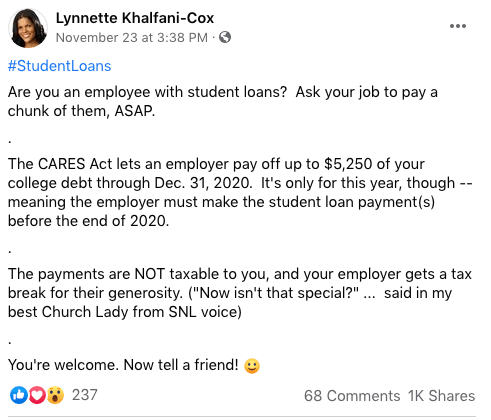I recently posted a student loan tip on social media that went crazy viral! It racked up tons of traditional media coverage, plus many thousands of likes and shares (not to mention comments and questions!) across Twitter, Facebook and Instagram — far more than any other single post I’ve shared.
So what was the tip? The CARES Act offers a host of financial benefits for individuals and businesses, including a little-known provision that lets employers make tax-free contributions to pay off up to $5,250 worth of an employee’s student loans – but only for a limited time.

Since nearly 45 million people in the U.S. owe roughly $1.8 trillion in student loans, this seems like a no-brainer benefit that borrowers and companies alike should be clamoring to take advantage of during the COVID-19 outbreak.
But relatively few people have pursued this financial relief, likely because of a lack of knowledge about what’s required and what’s involved.
To help clear up some confusion and shed light on this topic, here’s a list of list of frequently asked questions about employer assistance for student loan repayments.
When did this go into effect and how long does this benefit last?
Congress passed the CARES Act, also called the Coronavirus Aid, Relief and Economic Security Act, on March 27, 2020 to deal with the economic fallout from the coronavirus pandemic.
Section 2206 of the CARES Act includes a temporary provision, from March 27, 2020 through December 31, 2020, that revises Section 127 of the Internal Revenue Code and permits employers to make tax-free payments on employees’ qualified educational loans.
To be clear: the employer must make the payments no later than 11:59 pm on Dec. 31, 2020.
What counts as “qualified educational loans”?
A “qualified education loan” is a debt incurred by the employee in order to cover qualified higher education expenses such as tuition, fees and books.
According to the IRS, qualified education expenses do NOT include any amounts paid for the following items:
- Insurance
- Medical expenses (including student health fees)
- Room and board
- Transportation
- Similar personal, living, or family expenses (Translation: you can’t get your employer to pay for loans you took out to cover costs like your Netflix subscription, or your utility bills while you were in school. Sorry!)
Again, none of these expenses count as qualified educational costs. This is true even if you had to pay for the items above to a college or university as a condition of your enrollment or attendance. See IRS Publication 970 for more details.
Exactly what types of student loans qualify for this relief?
This tax-free employer benefit applies exclusively to federal student loans, which represent about 92% of all student loans. Under the CARES Act, federally held student loans are granted financial relief in several ways during the coronavirus pandemic.
First, borrowers don’t have to make payments on their student loans through December 31, 2020. (It was originally until Sept. 30, 2020, but then the date got extended). Additionally, student loan interest on federal student loans is reduced to 0% through Dec. 31, 2020, so you won’t accrue added cost/interest if you’re not paying on student loans from late March 2020 through the end of 2020.
And finally, the other MAJOR benefit for those with federal student loans — and the topic of this article — is that employers can pay off up to $5,250 worth of your federally held undergraduate and graduate school student loans, and this contribution is NOT included in your taxable income. For 2020, this employer-provided student loan repayment covers:
- All Direct Loans, such as:
Direct subsidized Stafford loans
Direct unsubsidized Stafford loans
Direct Parent and Graduate Plus loans; and
Direct Consolidation loans
- Federally held Federal Family Education Loan (FFEL) program loans
- Federally held Perkins loans
Don’t know if your loans are federally held or not?
To find out if your FFEL and Perkins are federally held, just visit http://studentaid.gov and check who is listed as the lender on your loan. If it says the Department of Education, that’s a federally held loan and it qualifies for this program.
Are private loans eligible for this program?
No, unfortunately, private loans do not qualify for this employer-provided assistance under the CARES Act; only federal student loans are eligible. Even though private student loans are a burden for many borrowers — especially people who went to graduate school or professional school — private loans represent only about 8% of the student loan market in dollar terms.
Read and Watch: Getting Relief for Your Private Student Loans
What other student loans are NOT eligible?
Under the CARES Act, the following other loans are not eligible for employer student loan repayment assistance:
- Refinanced loans
- Perkins loans
- FFELP loans that are not owned by the federal government
NOTE, however, that Perkins and FFELP loans can be combined into a Direct Consolidation Loan which is eligible. But for practical purposes, you may not have time to do that before Dec. 31, 2020. Furthermore, you might not want to consolidate certain loans, because doing so could affect your interest rate and the terms associated with that debt.
Case in point: one downside of debt consolidation is that it wipes out any payments you have made towards student loan forgiveness under the income based repayment program. Furthermore, consolidation disqualifies your Perkins loans from being forgiven too.
What’s the benefit to the employer and the employee?
Any payments an employer makes towards their employees’ qualified educational loans are tax advantaged because the employer gets to make the contributions on a tax-free basis. The bottom line is that an employer does not have to pay payroll taxes on these payments. Furthermore, the payments are excluded from the employees’ taxable income, meaning this student loan assistance is tax free for the worker. This structure allows tax advantages for both parties.
Employers get a nice tax break and boost employee morale, and workers get some help with their student loans, which are costly for many borrowers.
Don’t employers already help with educational costs?
Yes. Even before the CARES Act, Section 127 of the Internal Revenue Code allowed an employer to pay up to $5,250 per year toward employees’ qualified education expenses – for things like tuition or textbooks. But the CARES Act updated Section 127 and expanded this provision for qualified educational expenses to include student loan repayments. As a result, employers can pay up to $5,250 towards traditional educational expenses such as tuition, student loans, or a combination of both tax-free in 2020.
So I can get an employer to pay for my tuition AND pay off my student loans?
Yes. As long as the employer’s total educational assistance does not exceed $5,250.
Does the employer make the payment directly to me?
Yes, that is one possibility, but not the only option. An employer can give you the money directly – just by adding the student loan repayment help to your paycheck, or by giving you a year-end bonus payment. Alternatively, an employer can make a single payment, or even multiple payments, right to your student loan servicing company on your (the employee’s) behalf.
If my company agrees to pay off some of my student loans is this going to be deducted out of my paycheck or taken from my wages in any way?
No. Exactly, the opposite thing happens. Money can be ADDED to your paycheck, during the normal payroll cycle, to cover your student loan repayment.
If I’m married or have a kid, and I pay for my spouse or my child’s student loans, does that qualify?
No. Only loans incurred by the employee qualify; not loans of a spouse, child, parent or other relative.
What does an employer have to do to pay off my student loans?
If an employer doesn’t currently have a Section 127 Educational Assistance program, it will need to create/adopt one. It’s not complicated. Companies like Education Loan Finance help employers set up these programs easily and quickly. If an educational assistance program already exists at your organization, they will simply need to modify/update the language in the Section 127 plan to permit student loan payments.
A few other requirements include: the education assistance program must be offered in writing (no verbal deals); the student loan payments can’t discriminate in favor of highly compensated employees; and the terms and availability of the student loan assistance must be adequately communicated to employees.
Lastly, no more than 5% of the amounts paid can go to shareholders and owners who have more than 5% in the company’s stock or capital.
I want to ask my job about this, but I’m nervous about what I should say to my employer. Any suggestions?
Don’t be reluctant or even embarrassed to ask for this perk. Consider it like any other fringe benefit. Employers want to hire or retain top talent and student loan repayments are one way that smart, progressive organizations attract and keep good workers.
If you’re at a loss for what to say, try using the template email message offered from Education Loan Finance. They give you a good, informative and non-threatening email script to send to an employer.
What happens if my employer pays more than $5,250 in educational assistance benefits on my behalf?
The IRS says that if your employer pays more than $5,250 in educational assistance benefits for you during the year, you must generally pay tax on any amount over $5,250. How will the IRS know? Well, your employer is also supposed to include in your wages (Form W-2, box 1) the amount that you must include in income (and that includes the excess amount of educational assistance paid by the employer above $5,250).
What about people without college debt? If I don’t have any student loans, can I still just request this $5,250 in cash from my job?
No. One requirement of the new law is that employers can’t give employees the choice to pick between student loan help and some other form of compensation. So if an employee does not have college debt, they can’t get a different or extra type of compensation in lieu of student loan repayment assistance.
If my employer says NO, or they say they don’t offer an educational assistance program, is there anything else I can do?
Yes. One thing you might try is to ask your employer to convert unused PTO – paid time off – into the equivalent of a student loan payment, a year-end payment or some kind of cash bonus.
In other words, you would go to your boss or to the HR department and ask them to give you a check (by Dec. 31, 2020) that equals any amount of unused paid time off that you have earned, but not yet used in this calendar year. The Society for Human Resources Management, also known as SHRM, has some good info on this approach. Read up on it here.
I’m self-employed. Can my business get a tax break for paying my own student loans, and is that money still tax-free to me individually?
Yes and yes. According to the Internal Revenue Code, sole proprietors and partners in a partnership can utilize this $5,250 student loan benefit also. Why? Basically as an entrepreneur you are your own employee. Here’s what the tax code says:
I.R.C. § 127(c)(2) Employee —
The term “employee” includes, for any year, an individual who is an employee within the meaning of section 401(c)(1) (relating to self-employed individuals).
I.R.C. § 127(c)(3) Employer —
An individual who owns the entire interest in an unincorporated trade or business shall be treated as his own employer. A partnership shall be treated as the employer of each partner who is an employee within the meaning of paragraph (2).
Pro tip: because small business owners may operate businesses in many different structures — sole proprietorships, LLCs, S Corps and so on — I strongly recommend double-checking with a CPA or tax specialist about your own individual circumstances if you’re self-employed and want to utilize this tax break.
Is it possible this student loan deal could be extended into 2021?
Maybe. Some companies, like Fidelity Investments, are major advocates of making employer provided student loan repayment permanent, or at least extending this student loan assistance into 2021 or beyond. So I do expect a number of large firms, benefits companies and plan providers to lobby for this.
Additionally, tax pros say that once a tax break is given, it’s very hard to take it back. That leads some observers to believe that this student loan benefit may ultimately be here to stay. Furthermore, President Elect Joe Biden has already said he supports some form of student loan forgiveness. Therefore, with the new Biden-Harris administration taking office Jan. 20, 2021, many people think there’s a pretty good chance that Biden and/or members of Congress may choose to champion this type of relief.
I will stay on top of the latest developments regarding student loan assistance in 2021. So be sure to follow me on Instagram, Facebook and Twitter for the latest updates on student loans — and do share this set of FAQs with anyone you know who has college debt.










